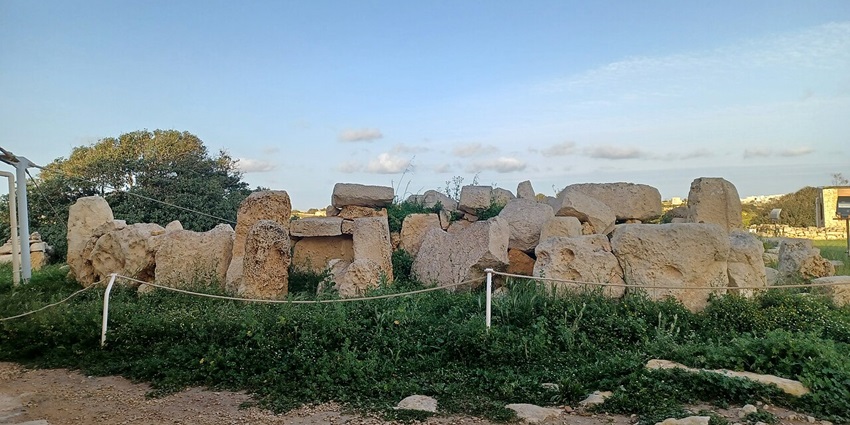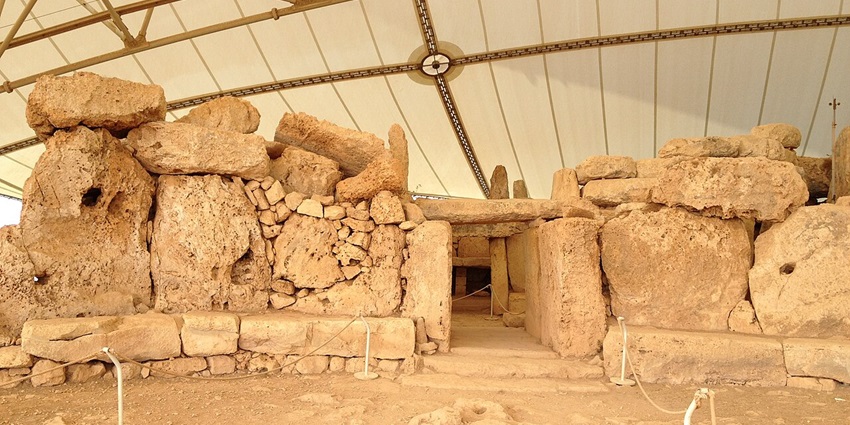Malta holds centuries of history in every stone, chapel, and fortress scattered across its islands. This small Mediterranean nation is home to some of the oldest free-standing structures in the world, beautifully preserved forts, and sacred pilgrimage sites. Exploring historical places in Malta means walking through ancient civilisations, medieval towns, and Baroque marvels, all within a few hours’ drive. From Neolithic temples to World War-era forts and sacred cathedrals, each site has a unique story to tell.
10 Must-Visit Historical Places In Malta
Here are ten prehistoric wonders of grand Baroque architecture, and the historical places in Malta reflect its rich and varied heritage to explore:
1. Ħal Saflieni Hypogeum

Photo: xiquinhosilva / Wikimedia Commons
The Ħal Saflieni Hypogeum is a relic from Malta’s deep past, one of the most historical places in Malta. Built over 6,000 years ago, this underground complex was carved entirely out of rock using only stone and antler tools. The site served as a collective burial place, but it was also spiritual. Wall carvings, red ochre markings, and the careful shape of certain chambers suggest it held meaning far beyond the practical. One room, known for its echoing acoustics, seems designed for voice and sound. Only 10 visitors are allowed per hour to preserve the environment inside.
How To Reach: Reachable via public bus routes from Valletta (routes 82, 88, or 119).
Entry Fee: €35 for adults, €20 for children and students / ₹3430 for adults and ₹1960 for children
Timings: Daily, 9 AM – 5 PM
Nearby Attractions: Tarxien Temples, Paola Parish Church, Għar Dalam Cave.
2. Mdina Old City

Photo: Zairon / Wikimedia Commons
Mdina, once the capital of Malta, is among the most architecturally intact historical places in Malta. The current walls and buildings reflect a mix of Norman, Baroque, and medieval styles of centuries of different rulers. The view from the city’s bastions stretches across the island, making it a favourite spot for visitors during sunset. St. Paul’s Cathedral, with its elaborate marble floor and twin bell towers, stands at the heart of Mdina. Several noble families still live here, and many of their ancestral houses are now open as museums.
How To Reach: Take a direct bus from Valletta (routes 51, 52, or 53) to Rabat.
Timings: 24*7
Nearby Attractions: St. Paul’s Catacombs, Mdina Dungeons, Rabat Domus Romana.
3. Fort St. Elmo

Photo: John Haslam / Wikimedia Commons
Fort St. Elmo stands at the edge of Valletta, where the two main harbours meet and is one of the historical places in Malta. It was built in 1552 by the Knights of St. John to protect this vital entry point. The loss was expected, but their defence stalled the Ottoman attack and gave time for reinforcements. Inside the fort is the National War Museum. It holds items from the siege, the French occupation, and both world wars. One of the museum’s most important exhibits is the George Cross, awarded to Malta for its courage during World War Two. Fort St.
How To Reach: From Valletta City Gate, walk straight through Republic Street to the tip of the peninsula
Entry Fee: €10 for adults, €6 for children / ₹980 for adults and ₹580 for children
Timings: 9 AM – 5 PM (Monday to Sunday)
Nearby Attractions: National War Museum, Lower Barrakka Gardens, Siege Bell War Memorial.
4. Hagar Qim Temples

Photo: Simon Burchell Wikimedia Commons
Ħaġar Qim stands on a rocky slope above the sea near Qrendi, facing the islet of Filfla, one of the most historical places in Malta. They were shaped and stacked without mortar, yet the structure still stands. The temple has thick curved walls, small chambers, and stone altars. How early islanders worshipped and buried their dead. Excavations found statues of wide-hipped female figures, carved stone slabs, and remains of animals, which may have been used in offerings. Every year around the summer solstice, sunlight passes through the doorway and lights a section of the inner room.
How To Reach: Take bus 74 from Valletta to Qrendi or drive along Route 1 to Wied iż-Żurrieq
Entry Fee: €10 for adults, €5.50 for children / ₹980 for adults and ₹540 for children
Timings: 9 AM – 5 PM.
Nearby Attractions: Mnajdra Temples, Blue Grotto, Wied iż-Żurrieq Bay.
5. St. John’s Co-Cathedral

Photo: Simon Burchell / Wikimedia Commons
St. John’s Co-Cathedral in Valletta, built by the Knights of St. John, is one of the historical places in Malta. The inside is covered in carved stone, gilded arches, and painted ceilings that reflect the wealth and power of the Order. Every chapel along the side aisles represents a different Langue, or national division, of the Knights. The most famous work here is Caravaggio’s The Beheading of Saint John the Baptist, which hangs in the Oratory. It is the only painting he ever signed. This cathedral was designed to show the Order’s strength after the Great Siege.
How To Reach: Located in central Valletta; walkable from the City Gate or any bus stop in the city
Entry Fee: €15 for adults, €7.50 for students / ₹1470 for adults and ₹730 for children
Timings: 9 AM – 4.30 PM (Monday to Friday)
Nearby Attractions: Grandmaster’s Palace, Upper Barrakka Gardens, and Republic Street.
6. Fort Rinella

Photo: Frank Vincentz / Wikimedia Commons
Fort Rinella is located in Kalkara and was built by the British, one of the historical places in Malta. It was one of four forts built around the empire to support a specific weapon, the 100-ton Armstrong gun. The gun at Fort Rinella was built in 1879 and could fire a shell weighing around 2,000 pounds across a distance of three kilometres. It was designed with a mechanical loading system powered by steam and hydraulic pumps, allowing faster reloading for a massive weapon. The fort also includes underground chambers, storage areas, and a protected gun platform.
How To Reach: Bus 3 or 213 from Valletta to Kalkara.
Entry Fee: €12 for adults, €5 for children / ₹1170 for adults and ₹490 for children
Timings: 10 AM – 5 PM Monday to Saturday
Nearby Attractions: Esplora Interactive Centre, Villa Bighi, Smart City Waterfront.
7. Tarxien Temples

Photo: Joonas L / Wikimedia Commons
The Tarxien Temples sit in a quiet residential part of Tarxien, a few minutes walk from the Paola church square. What followed was the excavation of four temple structures, placed side by side, built across different centuries. The site belongs to Malta’s late Neolithic period and includes some of the finest stonework found on the islands. Carved spirals, animal figures, and a large seated statue are all original. Some rooms have smooth stone benches and low walls with open spaces between them, believed to be altars.
How To Reach: Walkable from Paola station or reachable via bus (routes 81, 82, 84).
Entry Fee: €6 for adults, €4.50 for students and seniors / ₹590 for adults and ₹440 for children and senior
Timings: 9 AM – 5 PM.
Nearby Attractions: Hypogeum of Ħal-Saflieni, Church of St. Ubaldesca, Paola Square.
8. The Grandmaster’s Palace

Photo: Cosal / Wikimedia Commons
The Grandmaster’s Palace is one of the oldest and most historical places in Malta. Now it houses the Office of the President of Malta. The building faces St. George’s Square and occupies a large block in the city centre. Inside, the corridors are lined with full suits of armour, weapons, and tapestries that date back to the 18th century. The State Rooms and Council Chamber are open to visitors when official duties aren’t taking place. The walls and ceilings are covered with frescoes showing major events from the Order’s history.
How To Reach: Short walk from the Valletta City Gate; any city bus stops nearby
Entry Fee: €10 for adults, €6 for concessions / ₹980 for adults and ₹580 for children
Timings: 9 AM – 4.30 PM (Monday to Sunday)
Nearby Attractions: National Library, St. George’s Square, Merchant Street.
9. Mnajdra Temples

Photo: Docrgd / Wikimedia Commons
The Mnajdra Temples stand on a low ridge overlooking the sea near Qrendi, a few hundred metres downhill from the more well-known Ħaġar Qim site. The complex includes three separate temples joined by a shared forecourt. The oldest of the three is the smallest, built first and tucked to the left. The central and south temples are larger and show more advanced construction. The south temple is aligned so that sunlight passes directly through the doorway during the spring and autumn equinoxes. Mnajdra remains one of the most historical places in Malta.
How To Reach: Close to Hagar Qim; take bus 74 from Valletta or drive to Qrendi.
Entry Fee: Combined ticket with Hagar Qim: €10 / ₹980
Timings: 9 AM – 5 PM
Nearby Attractions: Hagar Qim, Blue Grotto, Maqluba Sinkhole.
10. Basilica Of The National Shrine Of The Blessed Virgin Of Ta Pinu

Photo: Diego Delso / Wikimedia Commons
The Basilica of Ta’ Pinu is located in the open countryside just outside the village of Għarb in Gozo. It stands on the site of a much older chapel that had long been associated with answered prayers and personal miracles. In 1883, a local woman claimed to have heard the voice of the Virgin Mary while praying in the small chapel. By the early 20th century, a new church was planned to accommodate the growing crowds. The basilica is built entirely from local limestone and follows a Romanesque design with a tall bell tower and finely carved interior columns.
How To Reach: Ferry from Cirkewwa to Gozo, then take bus 308 or drive towards Għarb
Timings: 7 AM – 7 PM.
Nearby Attractions: Ġgantija Temples, Ta’ Dbieġi Crafts Village, Dwejra Bay.
The historical places in Malta hold the marks of civilisations that shaped the island through temples, sieges, devotion, and rule. From Neolithic chambers to palaces that still function today, every corner reveals something preserved, not recreated. These ten places show how much Malta has witnessed across time and how much it has survived. Explore more such exciting packages offered by TripXL that promise an unforgettable adventure.
Cover Photo: Anton Zelenov / Wikimedia Commons


 WhatsApp
WhatsApp
 Twitter
Twitter









